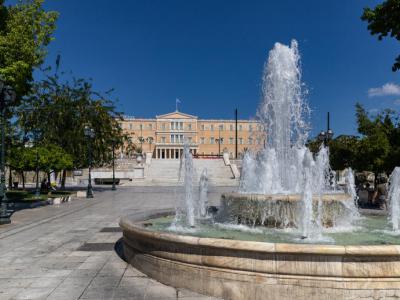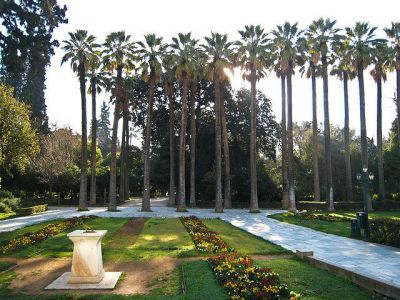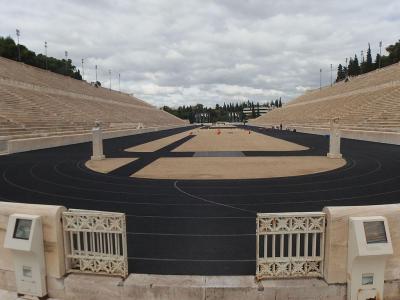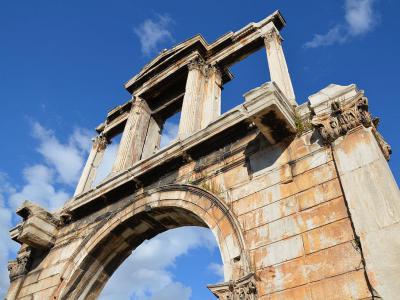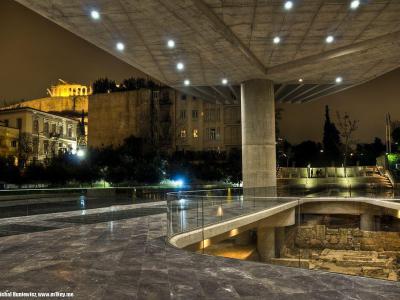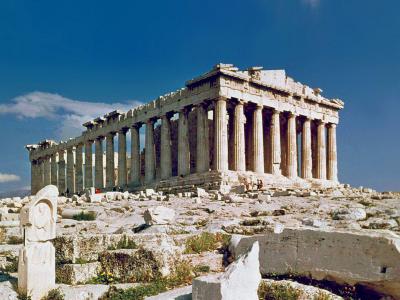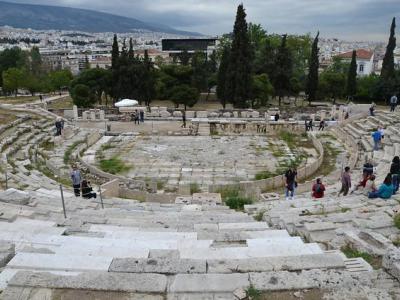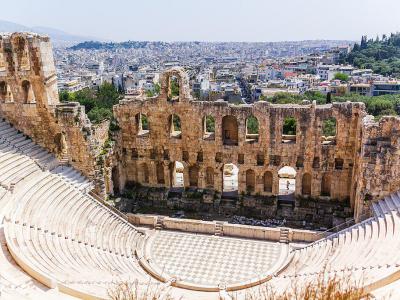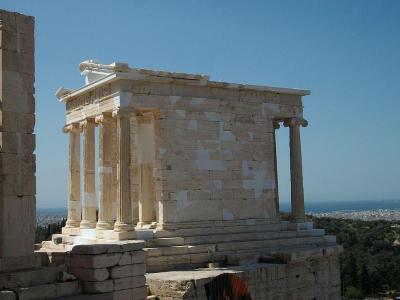Custom Walk in Athens, Greece by stemen10_0_eabff created on 2024-10-12
Guide Location: Greece » Athens
Guide Type: Custom Walk
# of Sights: 11
Tour Duration: 2 Hour(s)
Travel Distance: 4.2 Km or 2.6 Miles
Share Key: CKJSY
Guide Type: Custom Walk
# of Sights: 11
Tour Duration: 2 Hour(s)
Travel Distance: 4.2 Km or 2.6 Miles
Share Key: CKJSY
How It Works
Please retrieve this walk in the GPSmyCity app. Once done, the app will guide you from one tour stop to the next as if you had a personal tour guide. If you created the walk on this website or come to the page via a link, please follow the instructions below to retrieve the walk in the app.
Retrieve This Walk in App
Step 1. Download the app "GPSmyCity: Walks in 1K+ Cities" on Apple App Store or Google Play Store.
Step 2. In the GPSmyCity app, download(or launch) the guide "Athens Map and Walking Tours".
Step 3. Tap the menu button located at upper right corner of the "Walks" screen and select "Retrieve custom walk". Enter the share key: CKJSY
1) Syntagma Square (Constitution Square)
Constitution Square in Athens is where history, politics, and a good cup of coffee collide. This spacious landmark sits right in front of the 19th-century Royal Palace, which has been home to the Greek Parliament since 1935. And no, the square wasn’t just randomly named so-King Otto, Greece’s first monarch, was practically strong-armed into granting the country a Constitution here in 1843, thanks to a rather persuasive public and military uprising.
Nowadays, Constitution Square is still at the heart of the action. It’s not just a tourist hotspot-this is also Athens’ nerve center, linking visitors to top attractions by road, tram, bus, and subway. Political rallies, public gatherings, and plenty of people simply waiting for their Uber-this square sees it all on a regular basis.
Speaking of layout, Constitution Square has two levels-a bit like a giant marble stage set for both relaxation and spectacle. The central fountain, surrounded by benches, is perfect for a break, preferably with a Greek coffee in hand. Need WiFi? – No problem. Need a shade? – The pine and orange trees have you covered. And if caffeine calls, there are plenty of cafés ready to oblige. Oh, and in case you missed it, the whole square is clad in gleaming white marble, now with brand-new lampposts for that extra sparkle.
But the real showstopper is The Tomb of the Unknown Soldier. Guarded around the clock by the Evzones, Greece’s elite ceremonial soldiers, it’s a must-see. Their high-stepping routine, complete with kilts and pom-pom clogs, is as precise as it is fascinating. The tomb itself, unveiled on March 25, 1932, features a moving relief of a fallen Greek warrior (hoplite), forever frozen in time.
Tip:
If you fancy some retail therapy, just head to the lower end of the square-that’s where Ermou Street begins, Athens' ultimate shopping avenue. Happy strolling!
Nowadays, Constitution Square is still at the heart of the action. It’s not just a tourist hotspot-this is also Athens’ nerve center, linking visitors to top attractions by road, tram, bus, and subway. Political rallies, public gatherings, and plenty of people simply waiting for their Uber-this square sees it all on a regular basis.
Speaking of layout, Constitution Square has two levels-a bit like a giant marble stage set for both relaxation and spectacle. The central fountain, surrounded by benches, is perfect for a break, preferably with a Greek coffee in hand. Need WiFi? – No problem. Need a shade? – The pine and orange trees have you covered. And if caffeine calls, there are plenty of cafés ready to oblige. Oh, and in case you missed it, the whole square is clad in gleaming white marble, now with brand-new lampposts for that extra sparkle.
But the real showstopper is The Tomb of the Unknown Soldier. Guarded around the clock by the Evzones, Greece’s elite ceremonial soldiers, it’s a must-see. Their high-stepping routine, complete with kilts and pom-pom clogs, is as precise as it is fascinating. The tomb itself, unveiled on March 25, 1932, features a moving relief of a fallen Greek warrior (hoplite), forever frozen in time.
Tip:
If you fancy some retail therapy, just head to the lower end of the square-that’s where Ermou Street begins, Athens' ultimate shopping avenue. Happy strolling!
2) National Garden
Just behind the Voulí parliament building, this expansive 16-hectare (40-acre) park, held dear by all Athenians and formerly referred to as the "Royal Gardens", was officially renamed the National Gardens in 1923 by decree. The park's origins date back to the 1840s when Queen Amalía spearheaded its creation, even using the fledgling Greek navy to transport 15,000 seedlings from various corners of the world. Landscaping was entrusted to Prussian horticulturalist Friedrich Schmidt, an avid traveler who scoured the globe in search of rare plant specimens. Notably, Queen Amalía herself planted the avenue of Washingtonia fan palms, native to the southwestern United States.
While the gardens have undergone changes over the years, they remain a serene oasis in the heart of the city. Winding paths lead visitors past charming squares, park benches, and ponds inhabited by koi fish. Adding to the ambiance, visitors can explore remnants of Roman mosaics unearthed within the park and an ancient aqueduct. Throughout the gardens, you'll also encounter modern sculptures paying tribute to renowned writers such as Dionýsios Solomós (author of the Greek National Hymn), Aristotélis Valaorítis, and Jean Moreas. Towards the eastern end stands the neoclassical Zappeion Hall, constructed in 1888 as an Olympic facility. You will also find a duck pond, a small zoo, a small cafe, and a Children's Library and playground. The place is quite clean, suitable and safe for everyone in daytime.
Tip:
The pine-covered Ardittos Hill nearby offers one of the city's most serene and tranquil public spaces, along with stunning viewpoints.
While the gardens have undergone changes over the years, they remain a serene oasis in the heart of the city. Winding paths lead visitors past charming squares, park benches, and ponds inhabited by koi fish. Adding to the ambiance, visitors can explore remnants of Roman mosaics unearthed within the park and an ancient aqueduct. Throughout the gardens, you'll also encounter modern sculptures paying tribute to renowned writers such as Dionýsios Solomós (author of the Greek National Hymn), Aristotélis Valaorítis, and Jean Moreas. Towards the eastern end stands the neoclassical Zappeion Hall, constructed in 1888 as an Olympic facility. You will also find a duck pond, a small zoo, a small cafe, and a Children's Library and playground. The place is quite clean, suitable and safe for everyone in daytime.
Tip:
The pine-covered Ardittos Hill nearby offers one of the city's most serene and tranquil public spaces, along with stunning viewpoints.
3) Panathenaic Stadium (must see)
The Panathenaic is truly a remarkable historical site, being the only major stadium in the world constructed entirely of white marble. Its origins trace back to ancient times when it served as the venue for the athletic competitions of the Panathenaic Games, dedicated to the Goddess Athena and held every four years. The stadium underwent significant transformations, with a marble reconstruction in 329 BC and later expansion and renovation in 140 AD, accommodating up to 50,000 spectators.
Having fallen into disuse and disrepair after the 4th century AD, it was rediscovered and revitalized for the modern era, playing a pivotal role in the revival of the Olympic Games in the late 19th century. Despite its smaller scale compared to contemporary Olympic venues, the Panathenaic's elegant simplicity and iconic five Olympic rings continue to inspire awe. At the entrance, you'll encounter four stones engraved with the interesting history of the Olympics from the late 19th century to the present day.
The inaugural international Olympic Games in modern history were held here in 1896, with King George I of Greece opening the ceremony. Among participants were 241 male athletes from 14 countries, competing in 9 sports and 43 events. These early modern Olympic sports included athletics, cycling, fencing, gymnastics, tennis, shooting, swimming, weightlifting, and wrestling. Since then, athletes from across the globe have convened every four years, with the tradition enduring through the tumultuous 20th century wars.
Why You Should Visit:
A captivating place to explore, and you can enhance your visit with the free audio guide provided.
The on-site museum provides an engaging exhibition on the fascinating history of the Olympics.
Tip:
Don't miss the opportunity to climb to the upper tier for stunning views of the stadium.
Having fallen into disuse and disrepair after the 4th century AD, it was rediscovered and revitalized for the modern era, playing a pivotal role in the revival of the Olympic Games in the late 19th century. Despite its smaller scale compared to contemporary Olympic venues, the Panathenaic's elegant simplicity and iconic five Olympic rings continue to inspire awe. At the entrance, you'll encounter four stones engraved with the interesting history of the Olympics from the late 19th century to the present day.
The inaugural international Olympic Games in modern history were held here in 1896, with King George I of Greece opening the ceremony. Among participants were 241 male athletes from 14 countries, competing in 9 sports and 43 events. These early modern Olympic sports included athletics, cycling, fencing, gymnastics, tennis, shooting, swimming, weightlifting, and wrestling. Since then, athletes from across the globe have convened every four years, with the tradition enduring through the tumultuous 20th century wars.
Why You Should Visit:
A captivating place to explore, and you can enhance your visit with the free audio guide provided.
The on-site museum provides an engaging exhibition on the fascinating history of the Olympics.
Tip:
Don't miss the opportunity to climb to the upper tier for stunning views of the stadium.
4) Temple of Olympian Zeus (must see)
Even in its ruined state, the Athenian temple of Olympian Zeus remains a monument of awe-inspiring proportions, surpassing even the Parthenon in size. This colossal edifice saw its construction commence in the 6th century BC during the rule of the tyrant Peisistratos, who allegedly initiated the ambitious project to garner public favor. However, despite numerous attempts spanning many years to complete what would have been the greatest temple in the ancient world, it remained unfinished for over six and a half centuries.
In AD 132, the Roman emperor Hadrian, renowned for his admiration of classical Greek culture, dedicated the temple to Zeus Olympios during the Panhellenic festival, a competition of music and poetry held the year before the Olympics. This act took place during his second visit to Athens, and Hadrian also placed a gold and ivory inlaid statue of the god Zeus inside the temple. Regrettably, both the statue of Zeus and a colossal statue of the emperor himself have since been lost to history.
Today, only 15 of the original 104 Corinthian columns remain standing, each at a height of 17 meters (56 feet) – but enough to provide a sense of the temple's immense scale, which would have spanned about 96 meters (315 feet) in length and 40 meters (130 feet) in width. Nearby, there lies a 16th column that toppled during a storm in 1852, bearing witness to the passage of time. The temple's ruins extend beyond the towering columns, although entry into the temple may be restricted at times due to ongoing archaeological excavations.
Adjacent stands Hadrian's Arch, constructed in AD 131 and intentionally positioned to demarcate the boundary between the ancient city and the new Athens envisioned by Emperor Hadrian.
Tip:
For visitors who have acquired the Acropolis multi-site ticket, access to this historical site is automatically granted.
In AD 132, the Roman emperor Hadrian, renowned for his admiration of classical Greek culture, dedicated the temple to Zeus Olympios during the Panhellenic festival, a competition of music and poetry held the year before the Olympics. This act took place during his second visit to Athens, and Hadrian also placed a gold and ivory inlaid statue of the god Zeus inside the temple. Regrettably, both the statue of Zeus and a colossal statue of the emperor himself have since been lost to history.
Today, only 15 of the original 104 Corinthian columns remain standing, each at a height of 17 meters (56 feet) – but enough to provide a sense of the temple's immense scale, which would have spanned about 96 meters (315 feet) in length and 40 meters (130 feet) in width. Nearby, there lies a 16th column that toppled during a storm in 1852, bearing witness to the passage of time. The temple's ruins extend beyond the towering columns, although entry into the temple may be restricted at times due to ongoing archaeological excavations.
Adjacent stands Hadrian's Arch, constructed in AD 131 and intentionally positioned to demarcate the boundary between the ancient city and the new Athens envisioned by Emperor Hadrian.
Tip:
For visitors who have acquired the Acropolis multi-site ticket, access to this historical site is automatically granted.
5) Hadrian's Arch
Resembling a triumphal arch, this monumental gateway was built to celebrate the arrival of Roman Emperor Hadrian and pay tribute to his many benefactions to the city. It serves as a symbolic passage between the ancient part of Athens and the newly developed district, largely conceived during Hadrian's rule, which extended until the year 138 A.D. Hadrian was a great admirer of classical Greek literature, philosophy, and arts. During his reign, he generously sponsored several significant projects in Athens, including Hadrian's Library, the Hadrianic Aqueduct, and the completion of the Temple of Olympian Zeus, among others.
The entire structure dedicated to honoring Hadrian is constructed from marble quarried from Mount Pentelicus, located 18 kilometers away. In terms of design, it is fully symmetrical, both from the front and the sides; however, while the lower section draws inspiration from similar Roman arches, the upper part is typical of Greek ones. Inscriptions etched into the monument's surfaces celebrate the new Roman era: the northwest frieze bears the inscription, 'This is Athens, the Ancient city of Theseus,' whereas the southeast frieze declares, 'This is the city of Hadrian, and not of Theseus.'
Why You Should Visit:
One of the most important Roman monuments surviving in Athens, providing an opportunity to gain insights into the relationship between the Roman Empire and its province of Achaea, conquered by the Romans in the year 146 BC.
Tip:
While the monument can be admired from a distance during a stroll through Athens, for a closer view, you may opt to purchase a ticket for the Temple of Olympian Zeus or a combination ticket providing access to the city's major archaeological sites.
The entire structure dedicated to honoring Hadrian is constructed from marble quarried from Mount Pentelicus, located 18 kilometers away. In terms of design, it is fully symmetrical, both from the front and the sides; however, while the lower section draws inspiration from similar Roman arches, the upper part is typical of Greek ones. Inscriptions etched into the monument's surfaces celebrate the new Roman era: the northwest frieze bears the inscription, 'This is Athens, the Ancient city of Theseus,' whereas the southeast frieze declares, 'This is the city of Hadrian, and not of Theseus.'
Why You Should Visit:
One of the most important Roman monuments surviving in Athens, providing an opportunity to gain insights into the relationship between the Roman Empire and its province of Achaea, conquered by the Romans in the year 146 BC.
Tip:
While the monument can be admired from a distance during a stroll through Athens, for a closer view, you may opt to purchase a ticket for the Temple of Olympian Zeus or a combination ticket providing access to the city's major archaeological sites.
6) Acropolis Museum (must see)
Welcome to the Acropolis Museum, where ancient history meets sleek modern design-because nothing says “let’s preserve the past” quite like this four-story glass fortress perched atop millennia of buried treasures. Since 2009, this museum has housed every artifact unearthed from the Acropolis, making it the ultimate attic of Athenian greatness.
Step inside, and you’re greeted by an ancient owl-Athena’s favorite bird, dating back to 500 BC-watching over visitors with an expression that says, “I’ve seen it all.” As for the exhibits, there's a dazzling array of freestanding sculptures, marble figures, and friezes, each with a story to tell (if only marble could talk). And for a touch of drama, the museum’s glass floors and walkways let you peer down at the remains of an ancient civilization, like an archaeological reality show in progress.
The collections follow a timeline, beginning with finds from the Acropolis slopes-statues, reliefs, and pieces from the Sanctuary of Asclepius, the god of healing (who, let’s be honest, would have had his hands full in ancient Athens). Move on to the Archaic Collection, displayed in a soaring gallery, where mythological scenes play out in painted pediments-think Hercules wrestling monsters long before superhero movies were a thing. One level down, the post-Parthenon Collection showcases sculptures from the Temple of Athena Nike, architectural gems from the Propylaea, and five of the six legendary Caryatids from the Erechtheion (the sixth is currently “on leave” at the British Museum).
Cool, organized, and mercifully air-conditioned, the Acropolis Museum offers a captivating dive into ancient Athenian life-complete with multimedia presentations and expert guides ready to unravel centuries of history.
Tip:
Start with the video on the third floor, then work your way down through history. And when your brain needs a break, the second-floor terrace awaits-with panoramic views and a café serving Greek cuisine that even the gods would approve of.
Step inside, and you’re greeted by an ancient owl-Athena’s favorite bird, dating back to 500 BC-watching over visitors with an expression that says, “I’ve seen it all.” As for the exhibits, there's a dazzling array of freestanding sculptures, marble figures, and friezes, each with a story to tell (if only marble could talk). And for a touch of drama, the museum’s glass floors and walkways let you peer down at the remains of an ancient civilization, like an archaeological reality show in progress.
The collections follow a timeline, beginning with finds from the Acropolis slopes-statues, reliefs, and pieces from the Sanctuary of Asclepius, the god of healing (who, let’s be honest, would have had his hands full in ancient Athens). Move on to the Archaic Collection, displayed in a soaring gallery, where mythological scenes play out in painted pediments-think Hercules wrestling monsters long before superhero movies were a thing. One level down, the post-Parthenon Collection showcases sculptures from the Temple of Athena Nike, architectural gems from the Propylaea, and five of the six legendary Caryatids from the Erechtheion (the sixth is currently “on leave” at the British Museum).
Cool, organized, and mercifully air-conditioned, the Acropolis Museum offers a captivating dive into ancient Athenian life-complete with multimedia presentations and expert guides ready to unravel centuries of history.
Tip:
Start with the video on the third floor, then work your way down through history. And when your brain needs a break, the second-floor terrace awaits-with panoramic views and a café serving Greek cuisine that even the gods would approve of.
7) Parthenon (must see)
Presiding over the Acropolis like a timeless guardian of Athens, the Parthenon is one of the finest and most recognizable examples of classical architecture. This 5th-century BC temple was the brainchild of Pericles, the man who decided Athens needed an upgrade-preferably in glorious white Pentelic marble.
Replacing an older sanctuary, the Parthenon was dedicated to Athena, the city's patron goddess, whose grand 12-meter-tall statue, adorned in ivory and gold, once dazzled anyone lucky enough to lay eyes on it. More than just a temple, the Parthenon was a statement piece-loud and clear-about Athens' dominance following its victories in the Persian Wars and its leading role in the Delian League (uniting under its umbrella equal city-states against Persia). In other words, it wasn’t just about worship; it was about showing off.
Designed in the Doric style, the temple was built to withstand the test of time-but history had other plans. Over the centuries, it transformed from a Greek temple to a Byzantine church, then a Turkish mosque, and finally, in 1687, into a really unlucky storage facility for gunpowder. That decision ended about as well as you'd expect when the Venetians decided to bombard the Acropolis, causing a spectacular explosion. And if that wasn't enough, Lord Elgin of Great Britain came along in the 19th century and helped himself to much of its sculptural beauty, now sitting in the British Museum.
Yet, despite the looting, wars, and centuries of wear, the Parthenon still reigns supreme, standing as an enduring emblem of Greek culture and a favorite inspiration for neoclassical buildings worldwide.
Tips:
Go early-unless you enjoy waiting in long lines under the scorching Athenian sun.
Use both entrances to explore the site fully.
Get a combined ticket-it covers multiple iconic spots, including the Odeon of Herodes Atticus, the Theater of Dionysus, the Temple of Olympian Zeus, and the Ancient Agora. Because if you're traveling back in time, you might as well see it all.
Replacing an older sanctuary, the Parthenon was dedicated to Athena, the city's patron goddess, whose grand 12-meter-tall statue, adorned in ivory and gold, once dazzled anyone lucky enough to lay eyes on it. More than just a temple, the Parthenon was a statement piece-loud and clear-about Athens' dominance following its victories in the Persian Wars and its leading role in the Delian League (uniting under its umbrella equal city-states against Persia). In other words, it wasn’t just about worship; it was about showing off.
Designed in the Doric style, the temple was built to withstand the test of time-but history had other plans. Over the centuries, it transformed from a Greek temple to a Byzantine church, then a Turkish mosque, and finally, in 1687, into a really unlucky storage facility for gunpowder. That decision ended about as well as you'd expect when the Venetians decided to bombard the Acropolis, causing a spectacular explosion. And if that wasn't enough, Lord Elgin of Great Britain came along in the 19th century and helped himself to much of its sculptural beauty, now sitting in the British Museum.
Yet, despite the looting, wars, and centuries of wear, the Parthenon still reigns supreme, standing as an enduring emblem of Greek culture and a favorite inspiration for neoclassical buildings worldwide.
Tips:
Go early-unless you enjoy waiting in long lines under the scorching Athenian sun.
Use both entrances to explore the site fully.
Get a combined ticket-it covers multiple iconic spots, including the Odeon of Herodes Atticus, the Theater of Dionysus, the Temple of Olympian Zeus, and the Ancient Agora. Because if you're traveling back in time, you might as well see it all.
8) Theater of Dionysus (must see)
Comfortably set on the sun-kissed southern slopes of the Acropolis, the Theater of Dionysus is where drama as we know it was born. That’s right, before Broadway and Hollywood, this was the place where the ancient Greeks gathered to watch tragic heroes suffer and comic fools make a mess of things.
Now, why here, you ask? Well, it's all about the location! The theater sits conveniently close to the Temple of Dionysus, the god of wine, revelry, and, conveniently, drama. Every year in the 5th century BC, the Greeks threw a Dionysian festival-a six-day extravaganza filled with theatrical competitions where poets battled for glory. Imagine Aeschylus, Sophocles, and Euripides, nervously pacing backstage, hoping their tragedies would win over the crowd. The stakes? – Public honor, a handsome cash prize, and eternal bragging rights.
Fast forward a few centuries, and the Romans come in, super-sizing the place into a 17,000-seat venue. They even turned it into a gladiatorial arena-because, let’s be honest, they loved a bit of blood sport (more than sheer drama). Safety first, though! They added a fancy marble balustrade with metal railings to keep the audience from, well… joining the fight.
And here’s a fun detour-above the theater, you’ll find a cave dedicated to Artemis, the goddess of hunting, wilderness, wild animals, transitions, nature, vegetation, and childbirth. In the Byzantine era, this became the Our Lady of the Cave chapel, a place where desperate mothers brought their sick children, hoping for a miracle cure.
Today, the Theater of Dionysus stands as a timeless tribute to Athens’ cultural legacy. Take a seat on those ancient stones, soak in the atmosphere, and remember-you’re sitting where Western theater literally took center stage.
Now, why here, you ask? Well, it's all about the location! The theater sits conveniently close to the Temple of Dionysus, the god of wine, revelry, and, conveniently, drama. Every year in the 5th century BC, the Greeks threw a Dionysian festival-a six-day extravaganza filled with theatrical competitions where poets battled for glory. Imagine Aeschylus, Sophocles, and Euripides, nervously pacing backstage, hoping their tragedies would win over the crowd. The stakes? – Public honor, a handsome cash prize, and eternal bragging rights.
Fast forward a few centuries, and the Romans come in, super-sizing the place into a 17,000-seat venue. They even turned it into a gladiatorial arena-because, let’s be honest, they loved a bit of blood sport (more than sheer drama). Safety first, though! They added a fancy marble balustrade with metal railings to keep the audience from, well… joining the fight.
And here’s a fun detour-above the theater, you’ll find a cave dedicated to Artemis, the goddess of hunting, wilderness, wild animals, transitions, nature, vegetation, and childbirth. In the Byzantine era, this became the Our Lady of the Cave chapel, a place where desperate mothers brought their sick children, hoping for a miracle cure.
Today, the Theater of Dionysus stands as a timeless tribute to Athens’ cultural legacy. Take a seat on those ancient stones, soak in the atmosphere, and remember-you’re sitting where Western theater literally took center stage.
9) Odeon of Herodes Atticus
The Odeon of Herodes Atticus-or, as locals call it, the Herodeion. This name sounds like it belongs to an ancient superhero, but in reality, it’s a grand stone amphitheater sitting snug at the foot of the Acropolis. Built in 161 AD by a Greek aristocrat with a Roman title, Herodes Atticus, this wasn’t just any vanity project-it was a love letter to his late wife. And what better way to say “I miss you” than with a massive, acoustically perfect concert hall?
Originally, the Herodeion played host to the finest musical and theatrical performances of the ancient world-think tragic dramas, soaring choral arrangements, and instrumental masterpieces. The kind of cultural flex that made Athens the place to be. With no remnants of a roof (aside from the cedar one that once covered the orchestra area), this was an open-air spectacle from the very start.
A couple of millennia on, the Herodeion is still in business. By day, it’s a stunning ruin that whispers tales of the past. By night, it transforms into one of the dreamiest venues on Earth, hosting classical concerts, modern theater, and international acts beneath the Athenian moon.
Tip:
If you're planning a trip to Athens, check the event schedule ahead of time-nothing ruins a perfect ancient Greek night out like realizing all the tickets are gone. And since this is an open-air gig, always keep an eye on the weather. Rain or shine, though, this place remains one of the most breathtaking remnants of an era when entertainment was truly larger than life.
Originally, the Herodeion played host to the finest musical and theatrical performances of the ancient world-think tragic dramas, soaring choral arrangements, and instrumental masterpieces. The kind of cultural flex that made Athens the place to be. With no remnants of a roof (aside from the cedar one that once covered the orchestra area), this was an open-air spectacle from the very start.
A couple of millennia on, the Herodeion is still in business. By day, it’s a stunning ruin that whispers tales of the past. By night, it transforms into one of the dreamiest venues on Earth, hosting classical concerts, modern theater, and international acts beneath the Athenian moon.
Tip:
If you're planning a trip to Athens, check the event schedule ahead of time-nothing ruins a perfect ancient Greek night out like realizing all the tickets are gone. And since this is an open-air gig, always keep an eye on the weather. Rain or shine, though, this place remains one of the most breathtaking remnants of an era when entertainment was truly larger than life.
10) Temple of Athena Nike (must see)
The Temple of Athena Nike-a tiny, jewel-box of a temple perched atop the Acropolis. At just 11 feet (or 3.3 meters, for the metric-minded), it’s easy to miss in the shadow of its grander neighbors. But rest assured, it’s well worth a closer look. As you pass through the mighty Propylaea Gate, sneak a glance to your upper right-there it is, standing proudly on the edge of the rock wall, as if keeping an eye on everything below.
This little temple has had a rough ride through history, being knocked down not once, but twice! Thankfully, the ancient puzzle pieces were carefully put back together using original fragments, restoring its elegant form. And what a form it is-four Ionic columns at each end, perfectly symmetrical, just as it was in 420 BC. Back in the day, Athenians gathered here to toast their victories over the Persians (its frieze even depicts scenes from the Battle of Plataea in 479 BC-because what’s a victory without some artistic bragging?).
Designed by the architect Kallikrates, this temple wasn’t just for show. It served as both a shrine and a lookout post-because even the goddess of victory needs a good vantage point. Speaking of which, the temple’s balustrade once featured a stunning sculpture of Athena Nike. But there’s a twist! Unlike your usual winged depiction of the goddess, this one is wingless-a symbolic way of saying, “Victory is staying right here in Athens, thank you very much.”
And then there’s the legend. This very spot is where King Aegeus is said to have waited anxiously for his son, Theseus, to return from slaying the Minotaur in Crete. The plan? If Theseus survived, he’d raise white sails instead of black. The reality? He forgot. And when poor Aegeus saw the black sails, he assumed the worst and hurled himself into the sea-thus giving the Aegean Sea its name. Talk about a tragic mix-up...
So next time you visit the Acropolis, don’t just rush to the Parthenon. Take a moment to appreciate this small but mighty temple-because in Athens, even the little things come with epic stories.
This little temple has had a rough ride through history, being knocked down not once, but twice! Thankfully, the ancient puzzle pieces were carefully put back together using original fragments, restoring its elegant form. And what a form it is-four Ionic columns at each end, perfectly symmetrical, just as it was in 420 BC. Back in the day, Athenians gathered here to toast their victories over the Persians (its frieze even depicts scenes from the Battle of Plataea in 479 BC-because what’s a victory without some artistic bragging?).
Designed by the architect Kallikrates, this temple wasn’t just for show. It served as both a shrine and a lookout post-because even the goddess of victory needs a good vantage point. Speaking of which, the temple’s balustrade once featured a stunning sculpture of Athena Nike. But there’s a twist! Unlike your usual winged depiction of the goddess, this one is wingless-a symbolic way of saying, “Victory is staying right here in Athens, thank you very much.”
And then there’s the legend. This very spot is where King Aegeus is said to have waited anxiously for his son, Theseus, to return from slaying the Minotaur in Crete. The plan? If Theseus survived, he’d raise white sails instead of black. The reality? He forgot. And when poor Aegeus saw the black sails, he assumed the worst and hurled himself into the sea-thus giving the Aegean Sea its name. Talk about a tragic mix-up...
So next time you visit the Acropolis, don’t just rush to the Parthenon. Take a moment to appreciate this small but mighty temple-because in Athens, even the little things come with epic stories.
11) Anafiotika and Plaka Stairs (must see)
Nestled in the shadow of the Acropolis and frequently likened to the charming whitewashed villages of the rural Greek islands, Anafiotika is one of Athens' most delightful and idiosyncratic neighborhoods. Situated in the capital's Plaka district, it is poetically described as a "breeze of the Aegean" in the heart of the city, and as such exudes a unique character and ambiance.
Originally settled by the descendants of Anafi stonemasons, who arrived in the 19th century to work in the expanding capital, Anafiotika has retained much of its original charm. The area features simple stone houses, some of which are built directly into the bedrock. Many of them remain unchanged while others have undergone restoration over the years.
The cascades of vibrant bougainvillea and pots of geraniums and marigolds adorn the balconies and rooftops, adding to the prevailing tranquility that contrasts the bustle and noise of modern Athens. Back in antiquity, this area was abandoned because the Delphic Oracle claimed it as a sacred ground. Later, during Ottoman rule, locals ingeniously constructed their homes overnight, taking advantage of the law that granted ownership of the property if it were erected between sunset and sunrise.
Recently renovated, the Plaka Stairs neighborhood abounds in small eateries and bars scattered on the slopes of the Acropolis, particularly along Mnisikleous pedestrian street and its vicinity. Due to the hilly landscape, this street is designed in the form of steps, lined with cafes and restaurants on both sides. Creative and often compact seating arrangements along the steps create a lively atmosphere filled with music and the cheerful voices of the passers-by. This unique dining experience is guaranteed from early lunchtime until the evening.
Tip:
For those seeking a lovely spot for dinner and drinks, the Anafiotika Cafe Restaurant, located on the narrow Plaka Steps, offers a spacious patio area and a rooftop terrace that is perfect for catching the sunset.
Originally settled by the descendants of Anafi stonemasons, who arrived in the 19th century to work in the expanding capital, Anafiotika has retained much of its original charm. The area features simple stone houses, some of which are built directly into the bedrock. Many of them remain unchanged while others have undergone restoration over the years.
The cascades of vibrant bougainvillea and pots of geraniums and marigolds adorn the balconies and rooftops, adding to the prevailing tranquility that contrasts the bustle and noise of modern Athens. Back in antiquity, this area was abandoned because the Delphic Oracle claimed it as a sacred ground. Later, during Ottoman rule, locals ingeniously constructed their homes overnight, taking advantage of the law that granted ownership of the property if it were erected between sunset and sunrise.
Recently renovated, the Plaka Stairs neighborhood abounds in small eateries and bars scattered on the slopes of the Acropolis, particularly along Mnisikleous pedestrian street and its vicinity. Due to the hilly landscape, this street is designed in the form of steps, lined with cafes and restaurants on both sides. Creative and often compact seating arrangements along the steps create a lively atmosphere filled with music and the cheerful voices of the passers-by. This unique dining experience is guaranteed from early lunchtime until the evening.
Tip:
For those seeking a lovely spot for dinner and drinks, the Anafiotika Cafe Restaurant, located on the narrow Plaka Steps, offers a spacious patio area and a rooftop terrace that is perfect for catching the sunset.
